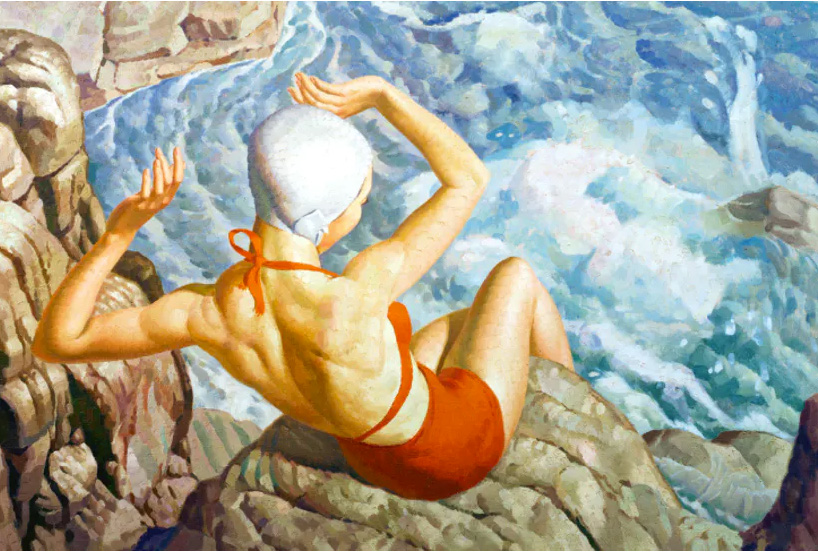
‘Spray’, by Harold Williamson (1939)
One day, somebody will stage an exhibition of artists taught at the Slade by the formidable Henry Tonks, who considered Cézanne a ‘curiously incapable’ menace, and a cracking show it will be. Until then, we must take what we can from exhibitions like True to Life: British Realist Painting in the 1920s & 1930s. Here, many of Tonks’s pupils, and others schooled with similar exactitude, can at last reclaim their rightful positions in British art after decades in the wilderness, pushed into the shadows by the alpha art of abstraction and the ironies of pop.
True to Life is a marvellous show. The portraiture is the stand-out stuff, dominated by the limpid virtuosity of Meredith Frampton and Gerald Leslie Brockhurst. Striving for a smooth, ‘brushless’ finish, these artists were harking back to the clarity and order of 15th-century portraiture, more Van Eyck than Van Dyck.
There’s an entrancing calm in these works, and a startling level of reality, or so it seems. While the finish may appear faultless, the construction is often more playful. Brockhurst’s ‘By the Hills’ (c.1939), the seductive poster image of this show, is actually a mix of two women. Preparatory drawings by James Cowie show the evolution of his painting, ‘A Portrait Group’ (1933/1940), and how it was assembled. The finished grouping of figures is another composite, both real and strange, vivid and flat.
Even better is Cowie’s portrait of his wife who stares out of the canvas, eyeing the viewer with a wry confidence. Things get weirder as the exhibition wanders away from portraiture, with some distinctly non-realist works by Edward Burra and Stanley Spencer indicating a darker, more confusing Britain than that shown elsewhere by the perfect picnickers and jolly hikers of James Walker Tucker and Harold Williamson.
‘Coming Clean’, a contemporary photography exhibition by Graham MacIndoe, presents a devastating modern realism. Twenty-five images record the photographer’s heroin addiction and the dismal existence he led shooting up in a bleak Brooklyn apartment. Self-portraits show the emaciated man injecting dirty brown liquid into his arms, lolling, sick and wasted, in his squalid flat surrounded by the detritus of his habit. Shooting through the filthy lens of a cheap digital camera, MacIndoe, who was in New York working as a photographer when his addiction began, never lost his eye for an image and the photos, though wretched and bleak, are faultless compositions that revel in the sour electric light and grimy detail of his charmless life.
An exhibition at the National Museum of Scotland throws an unexpectedly tender light on another modern reality. Sue Jane Taylor has spent 30 years studying the oil industry, producing meticulous, detailed drawings of tankers, docks, control rooms and, particularly, the lonely rigs that harvest oil and gas from the North Sea, and the people who work there. Age of Oil presents some of this work alongside a selection of objects and a few short videos.
It is an effective exhibition that carries the viewer around the boom town of Aberdeen, the once-vaunted Brent field and the decommissioning of the Murchison field, halfway to Norway. There’s pathos in the films of workers leaving the rig for the final time, shown alongside drawings and a small sample tin of oil, the last to be extracted from the field. With the final works in the show exploring the new offshore renewables industry we see how rapidly the oil era is closing. Taylor presents this demise with a powerful poignancy.
At Inverleith House in the Royal Botanic Garden, a group show celebrates the 50th anniversary of the garden’s Front Range Glasshouses. The result is an eclectic and energetic mix of work. Highlights include Bobby Niven’s elegant linear sculptures inspired by the seeds and fruit of the carpological collection and Laura Aldrige’s eco-dye fabric flooring bearing printed traces of exotic flora from the glasshouses.
Charlie Billingham’s exuberant installation recalls the playful spirit of the 18th and 19th centuries by taking edited sections of works by contemporary satirists and transforming them into giddy paintings that canter cheerfully around the room, playing off his hectic, patterned wall coverings and roughly decorated plant pots.
Billingham’s work connects well with the paintings by 19th-century botanist R.K. Greville on show upstairs. Conceived as illustrations to a proposed book on plant geography by John Hutton Balfour, these little paintings, thick in foliage and occasionally peopled by natives, were painted not on Pacific atolls or in the Sumatran rainforests they depict, but back in Scotland. The results are an exotic 19th-century fantasy.
Oliver Osborne’s paintings of rubber plants hang against an ochre linen wall, and what look like spatters of paint beneath each work are in fact embroidered. The detailed realism of the painted plants is undercut by the unexpected addition of collaged cartoons. Here, as elsewhere in Edinburgh this summer, nothing is quite what it seems.


